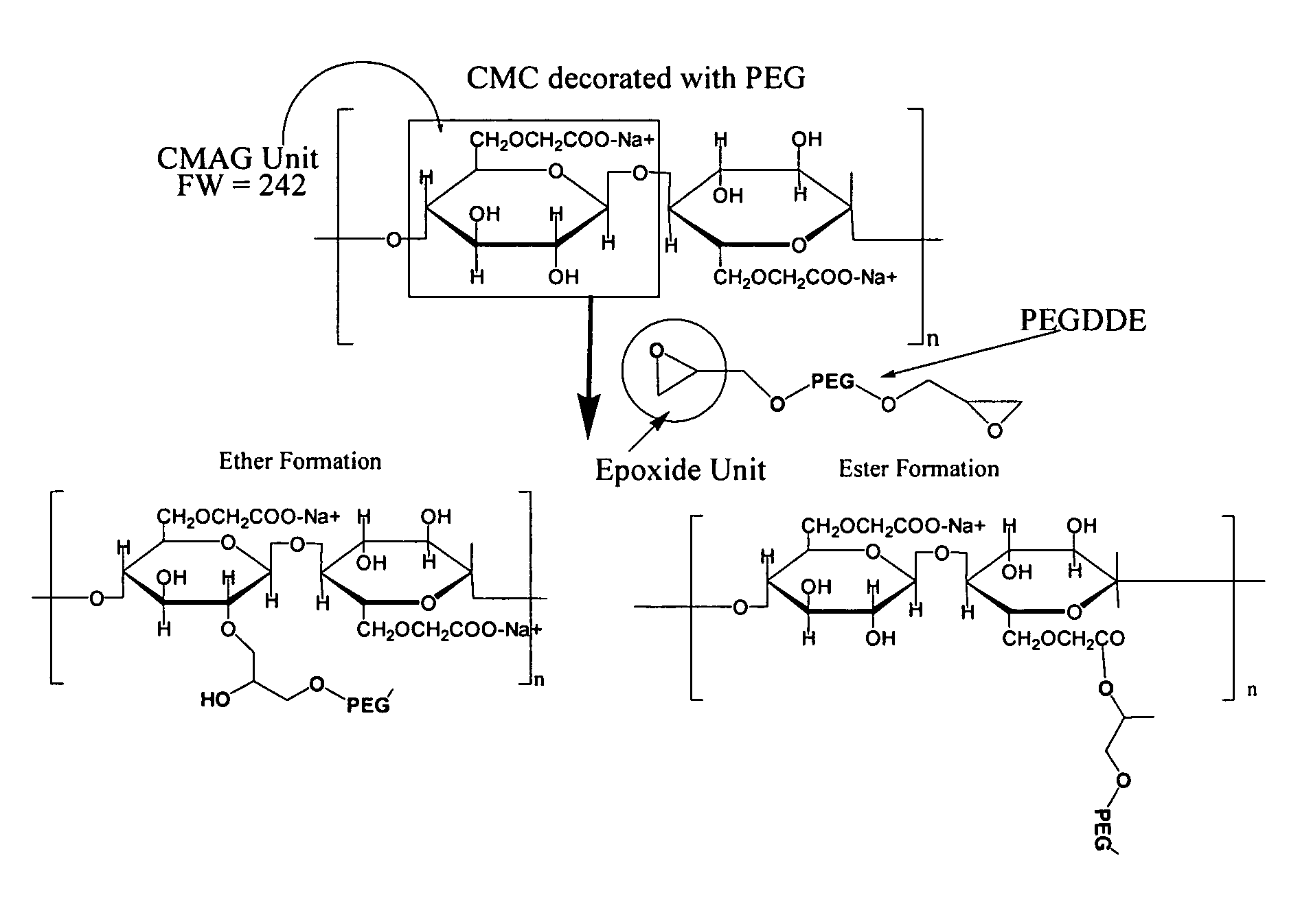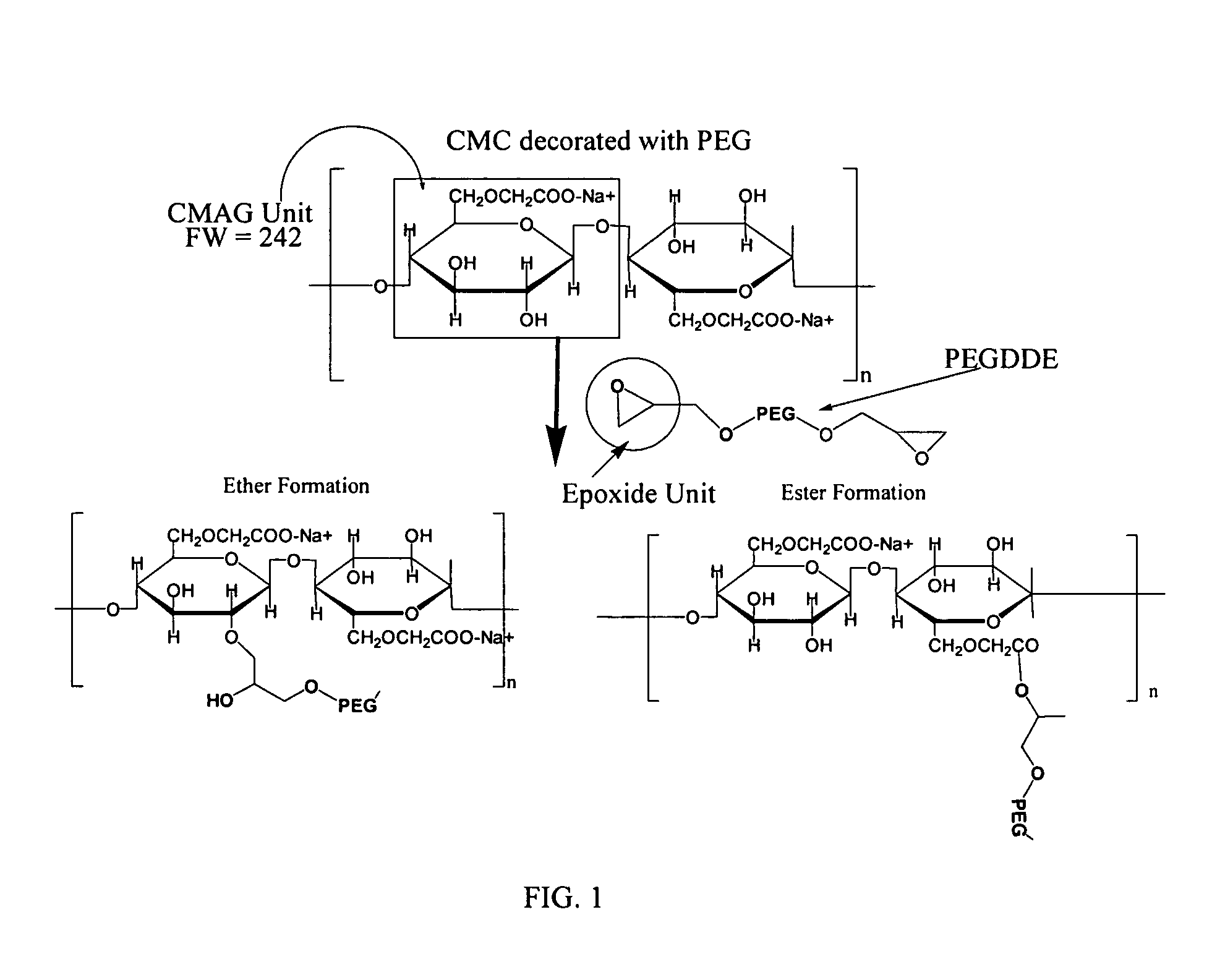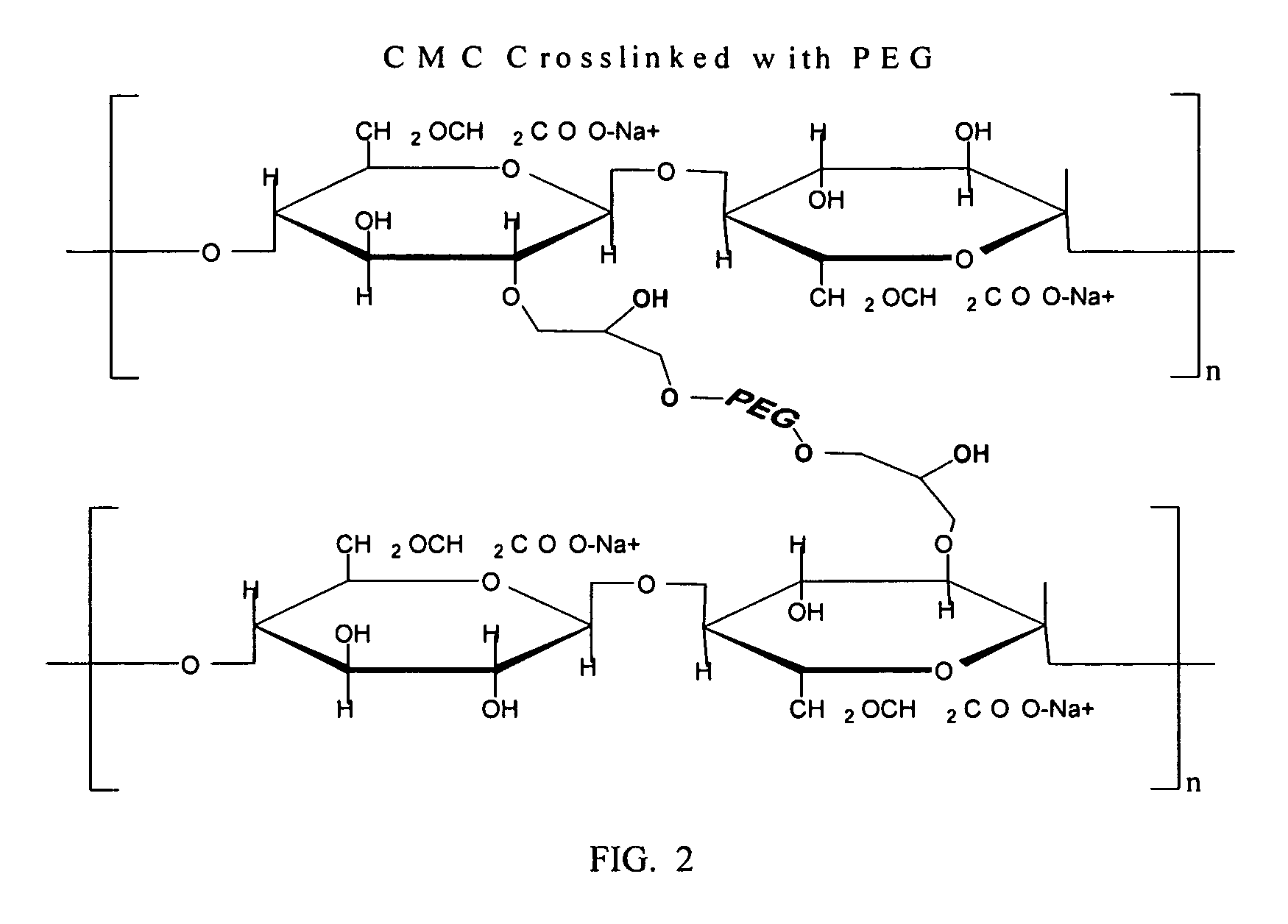Carboxymethylcellulose polyethylene glycol compositions for medical uses
a technology of carboxymethylcellulose and polyethylene glycol, which is applied in the field of compositions containing derivatized carboxypolysaccharides, can solve the problems of tissue stress, tissue damage and deterioration, and achieve the effect of improving the biocompatibility of the polymer material and high inherent elasticity
- Summary
- Abstract
- Description
- Claims
- Application Information
AI Technical Summary
Benefits of technology
Problems solved by technology
Method used
Image
Examples
example 1
Crosslinking of CMC A with PEGDDE at a CMAG / Epoxide Ratio of 0.8 / 1 in Dilute NaOH
[0213] To a 400 ml polypentene beaker we added distilled, deionized water (DIW) (250 mL) and NaOH (2.5 g; 60.25 mm). After 5 minutes of stirring at 400 rpm, CMC A (5.0 g; 40.83 mm OH) was added and stirring continued for 35 minutes at 25° C. Subsequently, PEGDDE, (6.884 g; 6.0 mL; 8.7 mm) was added neat and stirring was continued at ambient temperature for 90 minutes. After that time, we then heated the mixture to about 70° C. for 1 hour and about 90° C. for 2 hours. The mixture was then cooled to ambient temperature overnight.
[0214] The solution was diluted to a volume of about 250 mL with DIW and neutralized with 3.5 ml of glacial acetic acid. At this point the pH was 5.3 and 20% NaOH was added to bring the pH to 6.8. The resulting polymer was precipitated with IPA, collected and then ground in a blender with isopropyl alcohol / methanol (IPA / MeOH) 1:1 in a volume of about 250 mL. The granular solid w...
example 2
Crosslinking of CMC A With PEGDDE at a CMAG / Epoxide Ratio of 35.5 / 1 in Dilute NaOH
[0216] To a 400 ml polypentene beaker, we added DIW (250 mL) and NaOH (10 g; 250 mM) with mechanical stirring. After 5 minutes of stirring at 400 rpm, we then added CMC A (7.5 g; 67.3 mM OH) and stirring continued for 35 minutes at 25° C. Subsequently, we added PEGDDE (0.23 g; neat; 0.2 mL; 0.87 mm) and stirring continued at ambient temperature for 90 minutes then heated to a temperature of about 70° C. for 3 hours then cooled to ambient temperature overnight.
[0217] The solution was then diluted to a volume of about 250 mL with DIW and neutralized with glacial acetic acid to a pH of 6. The resulting polymer was precipitated with IPA, collected and then ground in a blender with MeOH 250 ml. The granular solid was collected and washed three times with about 50 mL of MeOH, then dried in a hood for 20 minutes, and the dried in vacuo at a temperature of about 60° C.
[0218] Rheological properties of a 30 m...
example 3
Crosslinking of CMC a with PEGDDE at a CMAG / Epoxide Ratio of 1.78 / 1 in Dilute NH4OH
[0221] In this example, to a 400 ml polypentene beaker we added DIW (250 mL) and 20% NH4OH (5 ml) under constant stirring for 5 minutes at 400 rpm. The resulting solution had a pH of 11. To this solution, we added CMC A (7.5 g; 67.3 mM OH) with constant stirring at 700 rpm for 35 minutes at a temperature of 25° C. At this time, PEGDDE (2.3 g; neat 2 mL; 8.7 mM) was added and stirring continued at ambient temperature for 2 hours and then another 2 ml (8.7 mM) of PEGDDE was added and stirring continued for a further 2 hours. The solution was then neutralized with dilute HCl to pH 6.8 and the polymer was precipitated with IPA and collected. The solid was ground in a blender with MeOH and the granular solid was collected and wash three times with about 50 mL of MeOH then dried in a hood for 20 minutes and the dried in vacuo at a temperature of about 60° C.
[0222]FIG. 6 depicts graphs of tan δ vs. frequen...
PUM
| Property | Measurement | Unit |
|---|---|---|
| molecular weights | aaaaa | aaaaa |
| molecular weights | aaaaa | aaaaa |
| concentration | aaaaa | aaaaa |
Abstract
Description
Claims
Application Information
 Login to View More
Login to View More - R&D
- Intellectual Property
- Life Sciences
- Materials
- Tech Scout
- Unparalleled Data Quality
- Higher Quality Content
- 60% Fewer Hallucinations
Browse by: Latest US Patents, China's latest patents, Technical Efficacy Thesaurus, Application Domain, Technology Topic, Popular Technical Reports.
© 2025 PatSnap. All rights reserved.Legal|Privacy policy|Modern Slavery Act Transparency Statement|Sitemap|About US| Contact US: help@patsnap.com



